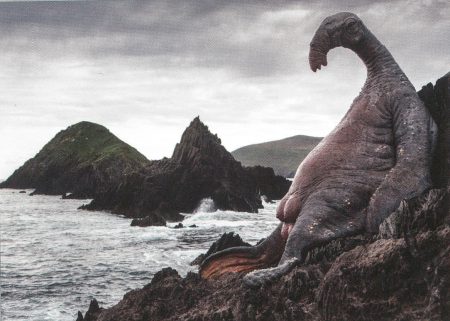 There’s a strange scene in The Last Jedi as Rey is following Luke Skywalker around his hermitage on the planet Ahch-To. Luke has apparently gotten into the habit of milking the planet’s local creatures — the remarkably relaxed thala-sirens that spend their time reclining against the rocks. He walks up to one of the creatures and squeezes green milk from its prominent udders. Then he drinks it, soaking his beard with the stuff.
There’s a strange scene in The Last Jedi as Rey is following Luke Skywalker around his hermitage on the planet Ahch-To. Luke has apparently gotten into the habit of milking the planet’s local creatures — the remarkably relaxed thala-sirens that spend their time reclining against the rocks. He walks up to one of the creatures and squeezes green milk from its prominent udders. Then he drinks it, soaking his beard with the stuff.
It’s a creepy moment that might be an homage to the blue Bantha milk of Luke’s childhood on Tatooine. One thing’s certain: in the Star Wars universe, milk comes in unusual colors. But what about on Earth? Without using food coloring, would we ever see such weird shades? No — but also yes, says David Barbano, a professor of food science at Cornell University. “Inside the white milk that you drink, it’s actually green, and you don’t know it,” he says.
Wait, what? To take a step back: milk is white because of the tiny particles of proteins and droplets of fat are suspended in it. These tiny particles reflect all the wavelengths of light back to your eyes, which your brain interprets as white, Barbano says. This milky color can vary a little from one type of dairy cow to another: Jersey cows, for example, can make yellower milk than Holsteins — probably because of a genetic difference that lets Jerseys pass more of the yellow pigments from the grass they eat into their milk. Most other pigments break down during digestion.
But skim milk doesn’t look as white. In fact, sometimes it can look downright blueish or greenish. That’s because when you take out some of those fat droplets to make skim milk, the light can penetrate further into the liquid through the glass and hit protein particles that absorb certain wavelengths of light. The light that’s reflected back out is more blue-green, and less snow white.
/cdn.vox-cdn.com/uploads/chorus_asset/file/9896663/Permeate_from_skim_milk_2.001.jpeg)
That color change gets even more obvious if you take out all the proteins and fat through a process called ultrafiltration, Barbano says. The fat and protein are set aside for cheesemaking, and the resulting transparent liquid, called permeate, is green. That’s because the ultrafiltration process leaves behind a molecule present in milk called riboflavin, or vitamin B2.
The riboflavin reflects greenish wavelengths of light, giving the clear liquid a grassy green hue. Typically, “you don’t see it because it’s masked by the fact that the particles of fat and the particles of protein are reflecting the light back,” Barbano says. “But when you take cow’s milk apart, the base color without the protein and the fat is actually green.”
So is Luke drinking an ultra-skim, riboflavin-flavored smoothie from the thala-siren? Probably not, because the liquid that soaks Luke’s beard is milky rather than clear. “Then it’s something else,” Barbano says — but he’d have to reserve judgement until a scientist can examine the stuff. Nothing here on Earth makes milk quite that color.
Source: The Verge









